What Do We Really Know About Reginald Fessenden?
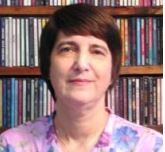
[December 2019] Among the early wireless pioneers, Reginald Fessenden is often credited with the first voice and music broadcast – a Christmas Eve concert. The reality is a bit more complex. If you are interested in the story behind the story – and Fessenden himself – Donna Halper offers true history and some clarity.
Before we begin our discussion about Reginald Fessenden, I would like to suggest we stop and consider something that ought to be obvious to everyone reading this article: facts matter.
It Ain’t Necessarily So
In other words, just because something has been endlessly quoted online, or mentioned in numerous books, it does not necessarily make it true.
Far too often, myths and legends get repeated so often that people begin to believe they must be true. For example, there is no evidence the story of George Washington and the cherry tree ever happened; it was actually the invention of a clergyman and author named Mason Locke Weems, who wanted to make sure people remembered Washington favorably, even if that meant exaggerating, or even making up anecdotes. I was taught the cherry tree story in school as a kid, and I am sure lots of kids still are taught so.
We broadcasters also have myths. For example, every year in early November we read somewhere that it is the anniversary of KDKA, “the first radio station in the USA” (or the entire world, depending on which source you encounter). But it has been well-documented that KDKA was neither the first station in the USA nor the world – there had been several other stations on the air before KDKA, and yes, those stations carried news and music, had a regular schedule, etc. (And no, KDKA was not the first to get a commercial license either, as I mentioned in an earlier piece I wrote for The BDR.)
But Westinghouse, then the owner of KDKA, had an amazing publicity department, they were able to spread their version of the story far and wide; it was picked up by newspapers from coast to coast and, later began to be stated as a fact in several early broadcast history textbooks.
AT&T did not invent commercials, either. And Sarnoff did not hear the Titanic’s call for help.
Fessenden and the First Broadcast
And that brings me to another of radio’s founding myths: Canadian inventor Reginald Fessenden, we are told, made the first-ever broadcast of voice and music, on Christmas Eve 1906.
Before some of Fessenden’s defenders find me on social media and tell me I am wrong to call this a myth, let me state for the record that Fessenden was indeed a great inventor, and I am certain he did broadcast voice and music many times. The issue is whether Christmas Eve 1906 was the first such broadcast.
And the evidence suggests it was not.
Fact-checking reveals a few troubling questions about the Christmas Eve 1906 story – most notably that Fessenden himself never mentioned that date as his first broadcast until the late 1920s (it did not even turn up in a 1910 profile from the Boston Globe,i nor in a 1925 series of articles he wrote for Radio News, which included a list of his many accomplishments).ii
Among the earliest print sources giving Christmas Eve 1906 as the first broadcast are a newspaper article from a syndicated columnist in 1930,iii a popular history of broadcasting by Alvin F. Harlow written in 1936, and the biography of Fessenden written by his wife Helen in 1940. Yet there is not one mention of the event in the magazines or newspapers of 1906-1928, not even when Fessenden himself wrote the article.
It Was Possible
Do not get me wrong. I am not saying, as historian James E. O’Neal does, that no such broadcast occurred.
In 2006, Professor Christopher Sterling and I wrote a journal article, and I wrote a subsequent follow-up, considering all the available evidence (or the lack thereof). We concluded that without contemporaneous documentation from newspapers or magazines, it was impossible to state with certainty that the broadcast had occurred. But it was equally problematic to say it never happened, since it is always difficult to prove a negative.
Sterling looked through many of Fessenden’s papers, as well as the papers of some of his contemporaries. I did a thorough search of many newspapers and magazines of Fessenden’s time (on microfilm and in various databases). But no matter where we looked, we were left with more questions than answers. And that result has not changed in the thirteen years since our articles were published.
Fessenden the Man
Let us look at what we do know about Reginald Aubrey Fessenden.
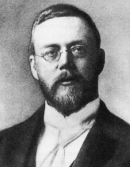
He was the eldest of four sons, born on October 6, 1866 in East Bolton, Quebec to the Reverend Elisha Fessenden, an Anglican minister, and his wife, Clementina.
As Fessenden would later point out in Radio News, his father’s lineage was American, and could be traced all the way back to the 1670s in Cambridge Massachusetts.iv
Elisha Fessenden had gone to Canada to attend McGill University in Montreal, and after studying for the ministry, the reverend and his family remained in Eastern Canada.
However, Reginald had no desire to follow in his father’s footsteps and become a clergyman. His passion was science.
By all accounts, he was such a good student that by the time he was in college, he was asked to teach mathematics to younger students. The precocious young man never completed his own university studies (although many newspaper biographical sketches claimed that he did; some even claimed he had a PhD).v
At just twenty years of age he accepted a position as a teacher and principal of the Whitney Institute, a school in Bermuda.vi Although that job lost its appeal fairly quickly, the good thing that emerged from the several years he spent in Bermuda was that he met Helen May Trott,vii the woman who would become his wife, as well as his advocate, defender, and publicist.
Fessenden and Edison
Determined to enter the field of science and invention, Fessenden decided the best place for him to be was in New York, where the great inventor Thomas Alva Edison worked.
Fessenden had long been fascinated by Edison, and became determined to meet him, which he finally did. Fessenden took an entry level job, but by 1887, Edison had become sufficiently impressed with the young man to name him Chief Chemist at the Edison Laboratory in East Orange, NJ.viii
However, there was a recurring pattern in Fessenden’s life back then: he never stayed in a job very long.
By 1890, he had become the Chief Electrician for the Westinghouse Electric & Manufacturing Company.ix In the summer of 1892 he was hired by Purdue University, where he became a Professor of Electrical Engineering.x The following spring (1893), he learned the Western University of Pennsylvania (now the University of Pittsburgh) was seeking someone to be the Chairman of their newly created Electrical Engineering Department; he applied, and was given the job.xi
It was while he worked in Pittsburgh that he became interested in wireless telegraphy and, then, in wireless telephony.
He had plenty of competition.
Wireless Telephony Pioneer
The late 1890s were filled with newspaper articles about many inventors – Guglielmo Marconi and Nikola Tesla were two of the best-known – and they spent much of the decade vying for attention, each claiming their system of wireless telegraphy transmitted messages farther.
Newspapers even were taking sides, with some boosting Tesla,xii and others boosting Marconi.xiii
Meanwhile, in France, Denmark, and Russia, local inventors were working on their own systems, each one trying to persuade the press that theirs was superior to anyone else’s.
In the United States, the publicity battle was ultimately won by Marconi.
Interestingly, long before he transmitted Morse code across the ocean in late 1901, Reginald Fessenden was able to generate some excitement of his own.
In late 1899, he asserted that he and his then-assistant Samuel M. Kintner had produced a receiver for wireless telegraphy that was “two thousand times more sensitive than the so-called ‘coherer’ of the Marconi system.”xiv
At the time, Fessenden said he expected his invention would be able to send wireless messages over a much greater distance than the ninety miles Marconi had achieved thus far; by April 1902, after several years of experimentation, he told the newspapers that a distance of two hundred miles was now achievable, and that two officers in the army’s Signal Corps, “General Greely and Captain Russell,” who had observed the tests, were “enthusiastic about the results.”xv
And in May of 1902, he told a newspaper that he was achieving equally promising results with wireless telephony and he planned to continue those experiments.xvi
Not Quite
The Center of Attention
Unfortunately for Fessenden, most reporters were more interested in the Marconi-Tesla competition, and the claims of a professor from a university in Pittsburgh did not get as much attention.
Some newspapers did carry the story of his 1902 experiments, but these reports were rarely on Page 1, and few journalists followed up. It was the same thing as had happened to Fessenden in 1900.
At that time, he was employed by the Weather Bureau, and he had persuaded that agency of the potential of his telegraphy system. Fessenden began demonstrating it, making the claim that he would soon be sending wireless messages over long distances, without interruption.xvii The claim was quoted in a few newspapers, but usually in a small article of one or two paragraphs.
Then, later that year, in December, Fessenden performed what may have been his first successful experiment transmitting his voice – he sent it over a distance of about one mile. Although the quality was poor, one of his assistants was able to hear it and acknowledge it in a Morse code message.
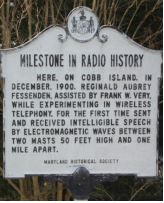
A plaque on Cobb Island, MD, about fifty miles Southeast of Washington, D.C. attests to this major achievement.xviii
But this experiment also received little attention, while Marconi’s telegraphic achievements in December 1901, and his subsequent claims about them, made big headlines from coast to coast.
For whatever reason, no matter what Fessenden did, reporters seemed much more interested in Marconi. The public also seemed fascinated by what he was doing, whether everyone fully understood his experiments or not.
In fact, many newspapers treated the young Italian inventor like a celebrity.
For example, in mid-December 1901, when Marconi reported he had transmitted a wireless message across the Atlantic, it was Front Page news.xix
And that was the pattern in Fessenden’s life.
A Voice in the Wilderness
Although some technical journals spoke favorably of him, he seldom got the mainstream media attention he felt he deserved, despite being a prolific and successful inventor.
It undoubtedly frustrated him that Marconi got so much adulation from the newspapers, when he believed his experiments had surpassed what Marconi had done. After all, Fessenden was able to broadcast not just Morse code but voice and music – he already had done it in 1900, and by 1905, he did it again!
He then repeated the experiment successfully in 1906.
This time The New York Times reported on his transmission of voice and music, an event they said had occurred on December 11th and was observed by a select audience of inventors, professors, and electrical engineers including men from Harvard, General Electric, and Bell Telephone.xx (Interestingly, the Times reporter got the date of the event wrong: the invitations to attend were sent on December 11, 1906, but the demonstration occurred on December 21st, according to John Grant, who attended, and wrote it up for the American Telephone Journal on January 26, 1907.)xxi
Lauded, But Largely Ignored
By 1909, Fessenden was successfully transmitting messages by wireless telephony from a 420-foot tower at Brant Rock, Massachusetts to listeners as far away as Washington, D.C.
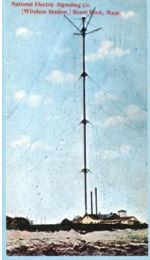
Fellow inventor Elihu Thompson told the press that Fessenden’s system had surpassed that of Marconi.xxii Even years later, Thompson would continue to say that Fessenden was a greater and more important inventor than Marconi.xxiii
Some of Fessenden’s contemporaries agreed with that assessment: for example, in a 1917 profile of him in The Electrical Experimenter, it said many people regarded him as “the greatest living Wireless inventor today,” and praised him as the man who “invented the first practical Wireless Telephone,” as well mentioning numerous other useful inventions he had given the world. (That profile, which did give a long list of his accomplishments, including the transmission of speech via the wireless telephone, did not mention a Christmas Eve 1906 broadcast.)xxiv
Yet an examination of the newspapers of Fessenden’s day showed that it was Marconi who was the media darling, something Fessenden never was able to achieve. One possible factor might have been the difference in the two men’s personalities.
Media Relationships
By many accounts, Marconi was very outgoing. He was also what we today would call media savvy: he did not mind talking to reporters, and he understood how to generate publicity for himself. In some ways, he was a showman; not only was he a talented inventor, but he was also good at capturing, and holding, the public’s attention.
Everything he did seemed to make news – whether his latest claim of a new invention,xxv or when he finally chose a bride,xxvi reporters covered it all, referring to him as a genius and noting how his discovery of wireless telegraphy had changed the world for the better.
Fessenden, on the other hand, was evidently not a “people person.” He seemed the most comfortable in his laboratory or working with his colleagues. Some sources, while acknowledging his brilliance, say he could be obstinate and abrasive, and unwilling to hide his annoyance with people he felt were not as intelligent as he was.xxvii
It is also worth noting that some of Fessenden’s writings could be quite contemptuous and, to the modern reader, quite bigoted.
For example, in the series he wrote during 1925 for Radio News, he asserted that white people (especially white Anglo-Saxon Protestants) were superior in intelligence to other races; said that Jews and Arabs were incapable of becoming inventors, since they seldom worked with their hands; and stated that the black race would revert to a “semi-barbarous state” if it did not come into contact with educated races like Caucasians. (In fairness, he was expressing views common in his time, but I would like to believe some people back then were offended.)
Fighting the Wrong Fights
Not only did Fessenden never receive the respect he undoubtedly deserved, he got into numerous very public disputes with the men who had backed his experiments.
Because he was not independently wealthy himself, he needed to find backers. But when that occurred, the backers often had their own ideas about where they wanted their money to go, and Fessenden clashed with them. Even further, when Fessenden did get patents for some of his many inventions, larger companies wanted to buy him out, or in several cases, take the patents away from him.
For example, his work with the National Electric Signaling Co (NESCO) from 1902-1910 ended badly. Despite coming up with many important innovations that improved radio transmission, his efforts did not translate to profits for NESCO, which fired him in early 1911.xxviii Lawsuits and bitter feelings resulted, and Fessenden was not paid the money he felt he had been owed.
For fifteen years, the case dragged on, with NESCO being sold and then sold again, causing even more delays. By the time the case was settled, it had turned into Fessenden versus eight manufacturers, and it was not until 1928 when things were finally resolved. He received $2.5 million in cash,xxix and a reputation for having taken on the “big boys” and winning.
But the struggles took a lot out of his health and he lived just four years more.
A few months before his death, one newspaper profile said he had more than 500 inventions,xxx while another said it was about 300.xxxi
Posthumous Praise
When Fessenden died of a heart attack in 1932, most newspapers ran the obituary from the Associated Press, which praised him for his genius, and described many of his inventions.
His obituary also noted he had been “repeatedly involved in patent litigation,” and said that his lawsuits were always successful.xxxii
But no, neither the obituary in The New York Times nor the Associated Press obit mentioned a Christmas Eve 1906 broadcast among his many achievements.
In 1987, the Canadian Government issued some postage stamps to commemorate achievements in science and technology.
One of those stamps honored Fessenden’s 1900 achievement.
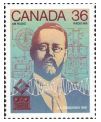
Autobiography Delayed
At the time of his death, Fessenden had not yet completed a planned autobiography.
The chapters that ran in Radio News in 1925 mysteriously stopped at the end of that year, and no new chapters were published. A few years later, his wife Helen made use of what he had written and added additional material.
The goal was to keep his legacy alive, which she did through her biography of her late husband, “Fessenden – Builder of Tomorrows,” which was published in 1940.xxxiii
From that book came the description of the iconic Christmas Eve 1906 broadcast that is so widely quoted today.
A True Pioneer
While debate about the Christmas Eve broadcast will probably continue, there is no doubt that Reginald Fessenden was a brilliant and often under-appreciated inventor who perfected radio transmission.
As more resources are discovered and digitized, perhaps we will one day be able to solve the mystery of what really happened in late December 1906. But it is certainly true that Reginald Fessenden changed people’s perceptions of what radio could do.
Thanks to his vision, radio was able to become a medium that utilized voice, rather than one that only utilized Morse code. And while he may not have gotten the level of attention (or the credit) that Marconi did, radio as we know it would not have developed without him.
For that, he deserves our gratitude.
– – –
Donna L. Halper, PhD is an Associate Professor of Communication and Media Studies at Lesley University, Cambridge MA and a prolific author of books and articles about broadcasting and the people who built it.
You can contact Donna at: dlh@donnahalper.com
Endnotes:
i “Wireless Station at Brant Rock Has Been in Touch with Egypt,” Boston Globe, June 26, 1910, M3.
ii “The Inventions of Reginald A. Fessenden,” Radio News, January 1925, 1142.
iii Robert Mack, “Broadcasting by Radio Came into Being Decade Ago,” Appleton (WI) Post-Crescent,
November 1, 1930, 10.
iv “The Inventions of Reginald A. Fessenden,” Radio News, March 1925, 1630.
v Raymond Francis Yates, Everyman’s Guide to Radio, Popular Radio Inc., 1927, 29.
vi “Leader in Radio Dies,” Kansas City Star, July 23, 1932, 2.
vii “The Inventions of Reginald A. Fessenden,” Radio News, June 1925, 2216.
viii “Pittsburg Men of National Prominence,” Pittsburg Post, June 9, 1905, 18.
ix “Reginald A. Fessenden—This Month’s Supplement,” The Electrical Experimenter, January 1917,
641.
x “An Electrician’s Promotion,” Richmond (IN) Item, August 6, 1892, 4.
xi “Western University of Pennsylvania,” New York Tribune, April 10, 1893, 10.
xii “Tesla’s Invention,” Buffalo Express, August 7, 1897, 2.
xiii “Perfecting His Wireless Telegraph,” Pittsburg Post, August 22, 1897, 18.
xiv “Wireless Telegraphy,” Scranton (PA) Tribune, December 18, 1899, 1.
xv “New Wireless Telegraphy,” New York Tribune, April 27, 1902, 5.
xvi “Wireless Telephone Has Been Perfected,” Pittsburgh Press, May 20, 1902, 9.8
xvii “The Weather Bureau to Investigate the Fessenden System,” Washington (DC) Evening Times,
January 20, 1900, 8.
xviii Donna Halper and Christopher Sterling. “Fessenden’s Christmas Eve Broadcast: Reconsidering an
Historical Event,” Antique Wireless Association Review, volume 19 (2006), 127.
xix “A Marvel Wrought,” Baltimore Sun, December 15, 1901, 1; see also “First Great Triumph of the
Twentieth Century,” San Francisco Examiner, December 15, 1901, 1.
xx “Fessenden Claims First Aerial Phone.” New York Times, October 7, 1915, 7.
xxi John Grant. “Experiments and Results in Wireless Telephony,” The American Telephone Journal,
January 26, 1907, 49.
xxii “New Wireless ’Phone,” New York Tribune, April 5, 1909, 1.
xxiii “Greater Than Marconi,” Brooklyn (NY) Daily Eagle, July 23, 1932, 20.
xxiv “Reginald A. Fessenden—This Month’s Supplement,” The Electrical Experimenter, January 1917,
641.
xxv “The Latest is the Wireless Auto,” (Carlisle PA) Evening Sentinel, February 21, 1907, 3.
xxvi See for example Silas B. Hutchins, “Guglielmo Marconi, Genius and Benedict,” Joliet (IL) Evening
News, March 31, 1905, 13.
xxvii Frederick Seitz, “The Cosmic Inventor: Reginald Aubrey Fessenden (1866-1932),” Transactions of
the American Philosophical Society, New Series, Vol. 89, No. 6 (1999), 56.
xxviii Gary L. Frost, “Inventing Schemes and Strategies: The Making and Selling of the Fessenden
Oscillator,” Technology and Culture, Vol. 42, No. 3 (July 2001), 465.
xxix “Death Takes Radio Expert of Early Day,” Seattle (WA) Daily Times, July 23, 1932, 12.
xxx Professor R.A. Fessendon [sic] Has to His Credit More Than 500 Valuable Inventions,” (Jefferson
City MO) Daily Capital News and Post-Tribune, November 1, 1931, 9-B.
xxxi “Prof. Fessenden Buried in Bermuda,” New York Times, July 24, 1932, 22.
xxxii “Death Takes Inventor of Radio Devices,” Cedar Rapids (IA) Gazette, July 23, 1932, 1.
xxxiii Frederick Seitz, “The Cosmic Inventor: Reginald Aubrey Fessenden (1866-1932),” Transactions of
the American Philosophical Society, New Series, Vol. 89, No. 6 (1999), 4
